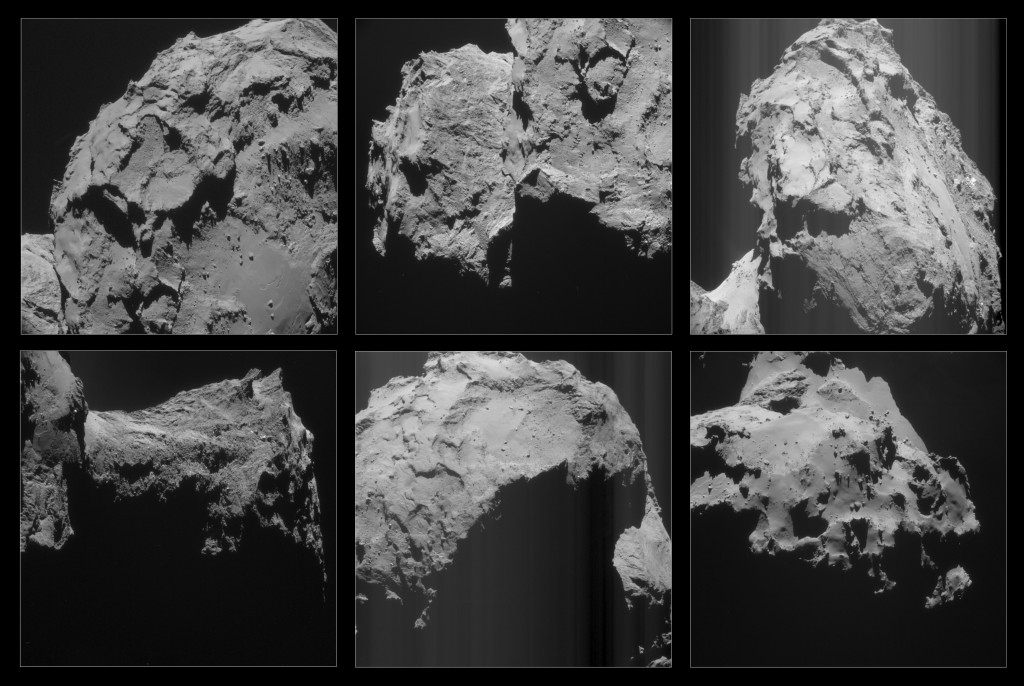Today marks a major release from the Rosetta downlink and archive groups of detailed images of Comet 67P/Churyumov-Gerasimenko taken by Rosetta’s Navigation Camera, or NAVCAM. The 1297 images, which can be accessed via the Archive Image Browser, were acquired between 1 August and 23 September. This corresponds to the final approach of Rosetta to the comet, its arrival at a distance of 100 km on 6 August and its transition to a global mapping phase at 30 km (click here for an animation describing the spacecraft’s trajectories at this time). It was during these two months that mapping and characterisation of the comet’s surface began, and Philae’s candidate landing sites were proposed, analysed and finally selected.
Movie: Getting to know Comet 67P/Churyumov-Gerasimenko. This animation of NAVCAM images follows the spacecraft’s approach to the comet from a distance of about 800 km on 1 August to a distance of about 62 km on 22 August 2014. Credits: ESA/Rosetta/NAVCAM – CC BY-SA IGO 3.0
Shown above is a taste of the images you can find in this latest release. The images are single frame 1024 x 1024 pixel images and cover the period 1-22 August. In late August the imaging scheme changed from single frame images to 2 x 2 rasters, once the spacecraft’s proximity to the comet meant that the nucleus overfilled the NAVCAM field of view. This transition is seen in the latest data release, and below is a montage of just a few incredible single-frame images you can find in the Browser from this period:

Comet close-ups from the 30 km mapping period are now available in the NAVCAM Archive Image Browser. Click to enter! Credits: ESA/Rosetta/NAVCAM – CC BY-SA IGO 3.0
Coming next month
At the end of May even more detailed images will be released in the NAVCAM image browser and in the Planetary Science Archive. This release will again cover two months – this time October and November – and therefore cover the transition from the 30 km mapping phase down to just 10 km from the comet’s surface. In addition, the image release will cover the exciting period leading up to and during the landing, including the days in which Philae was operating on the surface of Comet 67P/C-G.
In the meantime, we look forward to seeing what you do with the August-September image set; if you make movies, mosaics, shape models and so on, we’d be delighted if you share links in the comments box below.









Discussion: 13 comments
“Click to enter! ” link points to an “empty” page with one photo, the rest of the page is blank.
Hi Karl, it points to the landing page of the browser, where you see the entry to the Rosetta album – click through for albums from all different stages of the mission (not just for today’s release). Hope that helps!
So when do we finally get to see our ORISIS images – has Holger yet found an excuse to hold to them for even longer?
Oh wow. I see images not previously presented with the CometWatch Series. And there are more coming at the end of May?
NavCam. The gift that keeps on giving! 🙂
–Bill
Will we also see the equivalent from OSIRIS?
Wow, just watched that animation on the orbital trajectories. Amazing stuff. Pity it wasn’t around in the 80s; I could imagine Torvill & Dean ice dancing their way to a gold medal based on that!
Excellent site ! Many thanks – only question, is there still hope for Philae, or is it ‘game over’ for our brave little explorer ?
There is still hope. Philae may already be awake, but with insufficent energy to send a message.
Odds are improving daily over the coming two months.
Rosetta is frequently in listening mode.
Be sure, that currently at least the Philae people are optimistic.
_All my gratitude to ESA, H. NAVCAM Team and the ESAC’s Archive Team at Spain. The new image browser is modern in all senses. Not requiring additional power or the installation of APIs/executables at the user’s browser. Feel it fast, secure and stable.
Where (and how) can we access the OSIRIS images? I’m particularly interested in red / green / blue filtered images for creating natural-colour images. Thanks.
If this question has already been answered in another blog post, I apologize in advance but can you list the next several upcoming candidate dates for optimal communication attempts between Rosetta and Philae? Is there another location on the ESA website that lists these?
Taking a first, fast look at library 63:
It’s amazing!
Rosetta was such an awesome and challenging mission!